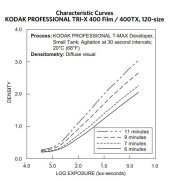Adrian Bacon
Member
Adrian Bacon submitted a new resource:
Kodak Tri-X 400TX H+D Curve with Replenished XTOL for 7:30 at 24C in a JOBO - A development time resource for replenished XTOL and Tri-X 400TX
Read more about this resource...
Kodak Tri-X 400TX H+D Curve with Replenished XTOL for 7:30 at 24C in a JOBO - A development time resource for replenished XTOL and Tri-X 400TX
For reference, and if anybody wants to discuss.
I've made these exposures as carefully as I could and eliminated as many variables as I realistically could. While it is not scientific, and certainly not up to ISO or probably manufacturer standards, it is as accurate as I can make it with what I have available to me, and certainly accurate enough that I thought it would be share-worthy.
Each of the curve points is a correctly exposed 18 percent grey card in full stop increments using a...
Read more about this resource...







